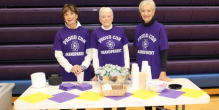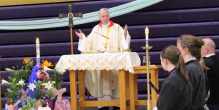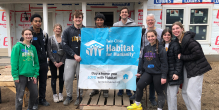A Post-Cost Toast: CDH Explores Costa Rica
Mary Grace Shearon '19
March 22, 2019
Another CDH Spring Break brought with it a CDH eco-immersion trip to Costa Rica! Fifteen students and three teachers were in for a treat when we left on March 1, the second day of Trimester 2 finals. Our first day traveling was stressful, but worth it. Once we stepped into the Costa Rican night and were embraced by the Chavarria-Villegas family (Luis Chavarria-Villegas ‘20 is an exchange student from Costa Rica), all our anticipation and nerves melted away. We marveled at the warm air in early March. For the first few days of the trip, we were in awe of the fact that we were even in Costa Rica. Although we were in the same time zone as Minnesota, the climate, altitude, and land were so different it seemed as if we were on a different planet entirely.
During the trip, we traveled throughout the Pacific side of Costa Rica. Highlights include visiting the Seelye family farm in the mountains, hiking up to a cave behind a waterfall, visiting the indigenous villages of the Térraba and the Boruca people, going to the beach, participating in community service at a school, and visiting Luis’ family.
Costa Rica is unique in that about 60 percent of the country is national parks, and Costa Rica abolished the military in 1948. For the most part, Costa Rica is a safe and environmentally conscious country. Our group had fun learning about all things Costa Rica. From the government to the culture and the Spanish language, we were immersed in Costa Rican society for ten days and learned a lot through pure experience.
We learned a lot about Costa Rica’s origins when we encountered the indigenous villages. Much like our Native populations in the United States, indigenous people in Costa Rica have been marginalized and are fighting to keep their language and cultures alive. The people of the Térraba and Boruca villages generously opened their homes to all of us; they told us their stories and cultures, cooked meals for us, and welcomed us overnight. Even though all members of the Térraba and Boruca villages spoke only Spanish and their native Indigenous languages, and most of us only spoke only English, relying on our guides Liz and Eric to translate, they were extremely generous and eager to share so much of their lives with us.
Sustainability was a large part of our trip. The fact that Costa Rica cares so much about the environment allowed us to discuss issues such as climate change, recycling, and the future of the Earth. The language used to discuss sustainability in Costa Rica is taken more seriously than here in the U.S. In the United States, the issues of climate change and sustainability can too often seem like a partisan issue, rather than an “all organisms who benefit from the earth” type of issue.
The Seelye family farm, in particular, told us a story of fighting for sustainability. The Seelye family’s devotion to the sustainability movement in Costa Rica is truly evident in the way they operate their farm. They get as many resources as they can from their farm, using even their cow’s waste as fertilizer, and as a source of gas for lighting a flame. We milked cows, fed goats, and learned how they make their cheese naturally, using all possible resources.
On our morning of departure, our group had the absolute pleasure of visiting exchange student Luis Chavarria-Villegas’ family at their home. The family welcomed all 18 of us into their home early in the morning and cooked breakfast for us. We shared conversation, camaraderie, and even saw two wild toucans in a tree across the street.
It was with bittersweet feelings that we unloaded our bus on Saturday, March 9 and said goodbye to our new Costa Rican friends Liz, Eric, and Ronald. Even though we had a blast, our tired and sunburned selves were, in a way, okay with going home to a snowy Minnesota that day.
Unfortunately for us, American Airlines had other plans. After our first flight to Dallas, our connecting flight left with our checked luggage and 19 empty seats. After a fitful night’s rest in the Dallas-Fort Worth International Airport, we split into two groups and traveled to Huntsville, Alabama. From there we went to our nation’s capital, Washington, DC, before touching ground back home over 24 hours later than we were supposed to.
Even though American Airlines tried their best to ruin our trip, they did not succeed. We had a great time together, learning about the environment and about Costa Rica. The students of the 2019 Costa Rica trip recommend it to current sophomores and juniors for next year!
If you’re interested in seeing more sights that were seen on the Costa Rica trip, check out this YouTube video about our journey.
|
Costa Rica Participants: |
|
Elias Brotman '20 |
|
Samantha Burrows '20 |
|
Lauren Davis '20 |
|
Luigi Dellessio '20 |
|
Lauren Disher '20 |
|
Connor Gleeson '21 |
|
Isabella Hansen '20 |
|
Lyric Kochendorfer '20 |
|
Dejanae Mendez '20 |
|
Justin Newhouse '20 |
|
Keira Elizabeth Obert '20 |
|
Nick Owsley '20 |
|
Madeline Plasch '20 |
|
Owen Michael Schaper |
|
Mary Grace Shearon '19 |
|
Luis Andres Chavarria Villegas '20 |
|
Chaperones: |
|
Julie Quinn Kiernan, Science Teacher |
|
Christina DeVos, Social Studies Teacher |
|
Peter Watkins, Religion Teacher |
Subscribe to our e-Newsletters
You might also like:
The Grandparents Association Makes a Difference in Students' Lives
The Grandparents' Association at CDH offers numerous opportunities for grandparents to get involved and make a meaningful impact.
Easter Mass Celebrated
Fr. Pat Kennedy led Easter Mass in the field house on April 4, with several students and staff taking part with the readings and music.
Students Gather for Habitat for Humanity Building Day
Mr. McGuire and Mr. Puent took a group of students to a Habitat for Humanity building day in St. Paul Park on March 15. Watch a video of them talking about this experience and service in general at CDH.




